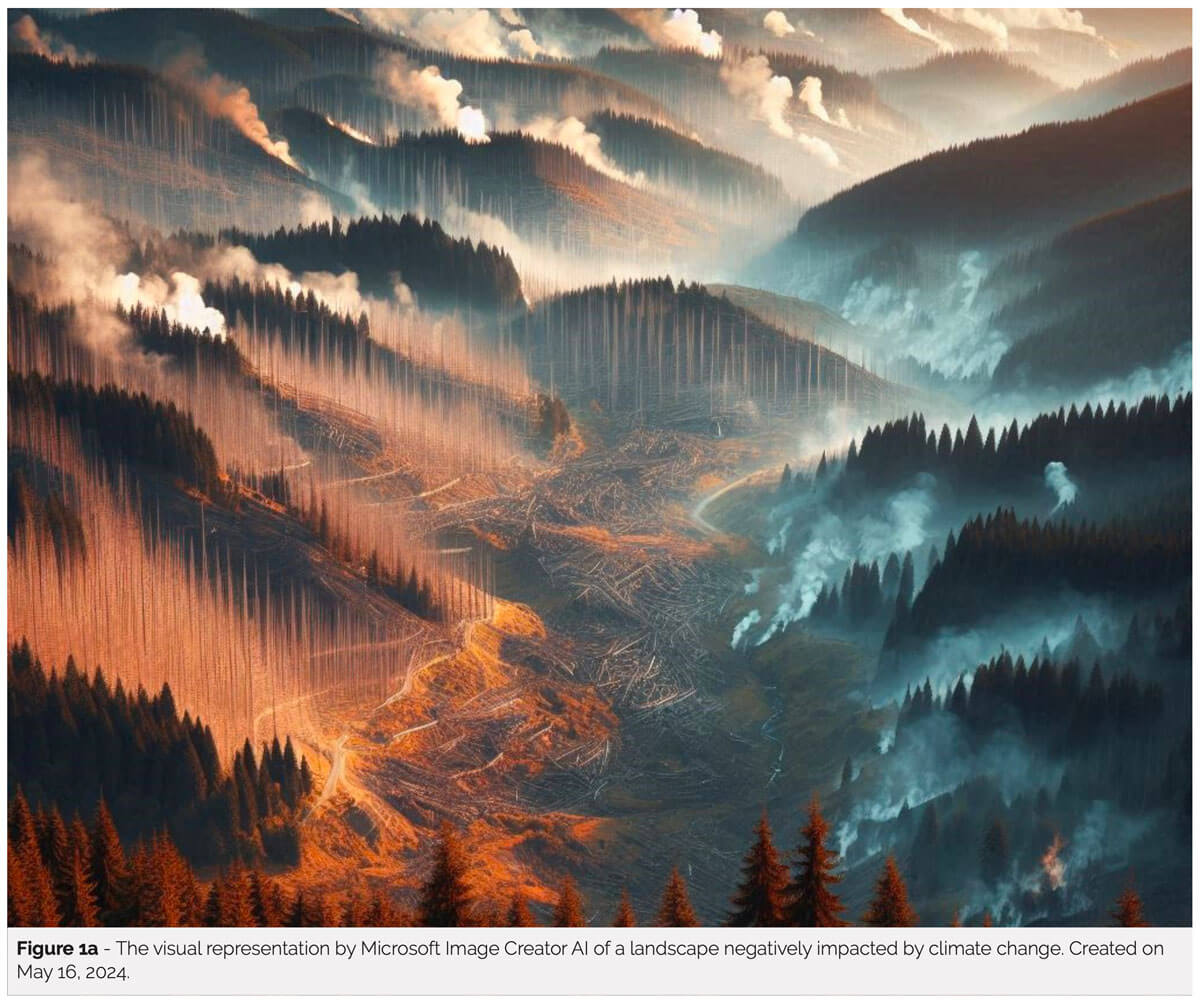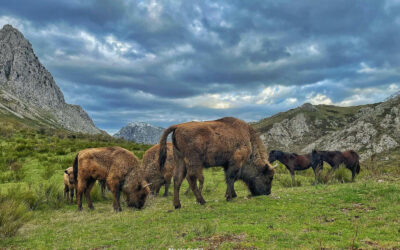Photo credit: Image prompt “A wilderness area with a backpacker close-up detail evening.” Generated with Microsoft Image Creator AI. Created on May 14, 2024.
Missing the Forest for the Algorithm
by Robert Dvorak
Editorial Perspectives
October 2024 | Volume 30, Number 2

What is the value of wilderness?
Wilderness holds immense value on multiple fronts, serving as a sanctuary for biodiversity and a source of inspiration and renewal for humanity. These untouched landscapes represent a tapestry of life, harboring a rich diversity of plant and animal species that have evolved over millennia. In preserving wilderness, we safeguard vital habitats and ecosystems, ensuring the survival of countless species and the resilience of natural processes. Moreover, wilderness areas act as living laboratories, offering invaluable insights into ecological dynamics and serving as benchmarks for understanding the impacts of human activity on the environment.
Beyond their ecological significance, wilderness areas offer profound benefits for human well-being. They provide spaces for solitude and reflection, offering respite from the hustle and bustle of modern life. Wilderness adventures cultivate a deep appreciation for nature, fostering a sense of stewardship and connection to the natural world. Furthermore, these wild places are essential for outdoor recreation, offering opportunities for hiking, camping, and wildlife observation that promote physical and mental health. Ultimately, the value of wilderness transcends mere monetary worth, enriching our lives spiritually, culturally, and ecologically.
What is the value of wilderness? Well, what you have just completed reading is the “value of wilderness” as described by ChatGPT 3.5, or at least what is presents when given the prompt “what is the value of wilderness described in two paragraphs.” Similarly, the photograph preceding this editorial was created by Microsoft Image Creator with the prompt “A wilderness area with a backpacker close-up detail evening.” These examples are intended to demonstrate that the application and incorporation of artificial intelligence (AI) across our society is increasingly rapidly. We are seeing AI grow across multiple sectors, including finance, health care, media and marketing, and education. But what will be the impact of AI on international conversation and wilderness efforts? What will be the potential positive and negative implications of greater integration of AI technologies and practices into our planning, research, and management?
It is important to recognize that AI is not just emerging. Scientists have been using AI technology and applications to address conservation problems for the past decade. Palminteri (2018) describes how scientists have begun using AI to track and predict poaching patterns across landscapes. AI is being used in the mining of social media photos across various platforms for species identification and population distributions connected to georeferenced photographs and visual content. And through machine learning, AI applications are improving their ability to identify and locate different species and pertinent information.


In addition to wildlife monitoring applications, Foyet (2024) has described the future direction of AI technologies. There are applications in global climate change modeling and landscape resilience planning across ecosystems. Practitioners can implement “smart resource management” that can distinguish hotspots, critical areas, and generate predictive maintenance models. Also, Foyet (2024) describes the greater social and cultural impact of AI technologies. AI-powered natural language processing and communication algorithms can be used to extract insights across media and information sources, detecting emerging issues and gaining the current public perception of conservation. AI-powered chatbots and virtual assistants can also answer conservation-related questions, create interactive learning, and disseminate accurate information. In these ways, the reach of AI in engaging the public on conservation issues and efforts can be immense.
However, there are tangible, negative consequences to AI application across conservation. Just as chatbots and virtual assistants can provide information or identify emerging issues, there is distinct selectivity in such a narrative. The technology is still influenced by our perceptions and the magnitude of its impacts are by the expression (or lack thereof) of our societal values. AI can equally represent the perceptions or reality of nature. In Figures 1a and 1b , I queried Microsoft Image Creator to represent “a landscape negatively impacted by climate change” and “nature and a pristine forest.” Each image, at best, only reflects a programmed interpretation of how these concepts can be represented. Additionally, interpretations can be modified, manipulated, and changed over time. Just as Microsoft Image Creator has functional toolboxes to “erase and add” content from your image, so too can we as a society modify the perceptions over the consequences of climate change, threats to natural ecosystems and endangered species, or the value of wilderness and protected areas.
It is uncertain where AI technology will go in the future. But it is evident that it can be a powerful tool to share and create knowledge, for better or worse. As with any tool, the application and implications of it are driven by those who wield it. We have an opportunity to better utilize this tool for the benefit of conservation and wilderness preservation. With responsible application, AI technologies might less represent the “artificial” and instead contribute to the “reality” of wild places.
In this issue of IJW, Pablo Garrido suggests the necessary prerequisites for rewilding. Jesse Engebretson and Courtney Larson discuss the benefits and tradeoffs of eDNA in wilderness management. Will Rice introduces the Western Wildlands digital archive. And Alexandra Locquet and Stéphane Héritier continue our “Wilderness Babel” series with the impossibility of translating “wilderness” into French and describing when ecological meaning fails to express cultural complexity.
ROBERT DVORAK is editor in chief of IJW and professor in the Department of Recreation, Parks, and Leisure Services Administration at Central Michigan University: email: dvora1rg@cmich.edu.
References
Palminteri, S. 2018. Scientists tackling conservation problems turn to artificial intelligence. Mongabay. https://news.mongabay.com/2018/05/scientists-tackling-conservation-problems-turn-to- artificial-intelligence/.
Read Next
Rewilding Prerequisites: An Ecocentric Approach
Rewilding is increasingly gaining momentum as a conservation practice in Europe.
Trusting Tech and Wilderness in the 21st Century
A Response to Keeling’s The Trouble with Virtual Wilderness
Benefits and Trade-Offs of Environmental DNA (eDNA) in Wilderness Character Monitoring
Visitor Perspectives on Removing and Maintaining Dams in Wilderness



